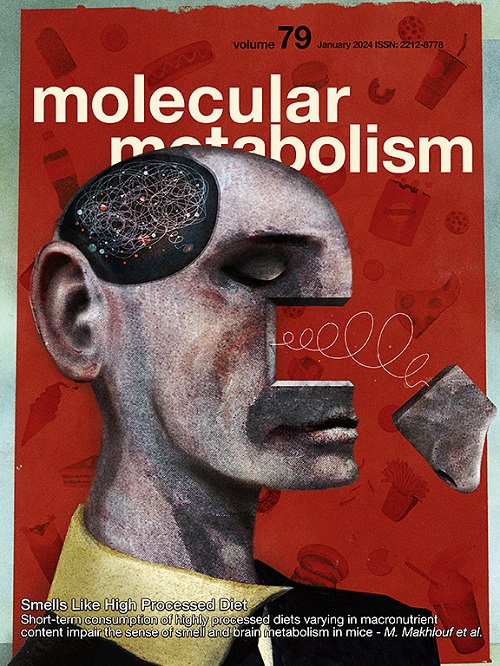Vitamin D receptor signalling regulates the diet-driven metabolic shift during weaning
IF 7
2区 医学
Q1 ENDOCRINOLOGY & METABOLISM
引用次数: 0
Abstract
Objective
Weaning in mammals is associated with a shift in the metabolism, driven by the differences in the macronutrient composition of milk and post-weaning diet. Milk has a higher fat content compared with the carbohydrate-enriched solid food. Malnutrition during this stage could affect this transition with long-term adverse effects. The role of micronutrients during this transition is not well understood.
Methods
We used mice lacking a functional vitamin D receptor (VDR) to study the role of vitamin D signalling in the metabolic transition during weaning.
Results
We demonstrate that after weaning, VDR knockout mice exhibit systemic energy deprivation and higher lipolysis in inguinal white adipose tissue, probably due to increased norepinephrine signalling via protein kinase A (PKA) and extracellular signalling-regulated kinase (ERK) pathways. The energy deprivation in vdr−/− mice is associated with defective liver glycogenolysis, characterized by increased expression of protein phosphatase-1 alpha and decreased glycogen phosphorylase activity. However, restoration of serum calcium and phosphate levels by a rescue diet is sufficient to restore energy metabolism in vdr−/− mice. Interestingly, maintaining a high-fat-containing milk-based diet post-weaning could prevent the onset of energy deprivation, liver glycogen storage defect, and adipose atrophy in these mice.
Conclusion
Our data show that vitamin D-signalling is essential for the adaptation of mice to the dietary shift from high-fat-containing milk to post-weaning carbohydrate-enriched diets. It also reveals a novel macronutrient–micronutrient interaction that shapes the metabolic flexibility of the individual based on the dietary composition of nutrients.

维生素D受体信号调节断奶期间饮食驱动的代谢转变
哺乳动物断奶与代谢的变化有关,这是由牛奶和断奶后饮食中常量营养素组成的差异所驱动的。与富含碳水化合物的固体食物相比,牛奶的脂肪含量更高。这一阶段的营养不良可能会影响这一转变,产生长期的不良影响。微量营养素在这一转变过程中的作用尚不清楚。方法利用缺乏功能性维生素D受体(VDR)的小鼠,研究维生素D信号在断奶代谢转变中的作用。结果:断奶后,VDR基因敲除小鼠表现出全身能量剥夺和腹股沟白色脂肪组织中较高的脂肪分解,这可能是由于通过蛋白激酶A (PKA)和细胞外信号调节激酶(ERK)途径增加的去甲肾上腺素信号。vdr - / -小鼠的能量剥夺与肝糖原溶解缺陷有关,其特征是蛋白磷酸酶-1 α表达增加,糖原磷酸化酶活性降低。然而,通过救援饮食恢复血清钙和磷酸盐水平足以恢复vdr - / -小鼠的能量代谢。有趣的是,在断奶后维持高脂肪牛奶饮食可以防止这些小鼠能量剥夺、肝糖原储存缺陷和脂肪萎缩的发生。我们的数据表明,维生素d信号对于小鼠适应从高脂肪牛奶到断奶后富含碳水化合物的饮食转变至关重要。它还揭示了一种新的宏量营养素-微量营养素相互作用,这种相互作用根据营养物质的膳食组成塑造了个体的代谢灵活性。
本文章由计算机程序翻译,如有差异,请以英文原文为准。
求助全文
约1分钟内获得全文
求助全文
来源期刊

Molecular Metabolism
ENDOCRINOLOGY & METABOLISM-
CiteScore
14.50
自引率
2.50%
发文量
219
审稿时长
43 days
期刊介绍:
Molecular Metabolism is a leading journal dedicated to sharing groundbreaking discoveries in the field of energy homeostasis and the underlying factors of metabolic disorders. These disorders include obesity, diabetes, cardiovascular disease, and cancer. Our journal focuses on publishing research driven by hypotheses and conducted to the highest standards, aiming to provide a mechanistic understanding of energy homeostasis-related behavior, physiology, and dysfunction.
We promote interdisciplinary science, covering a broad range of approaches from molecules to humans throughout the lifespan. Our goal is to contribute to transformative research in metabolism, which has the potential to revolutionize the field. By enabling progress in the prognosis, prevention, and ultimately the cure of metabolic disorders and their long-term complications, our journal seeks to better the future of health and well-being.
 求助内容:
求助内容: 应助结果提醒方式:
应助结果提醒方式:


